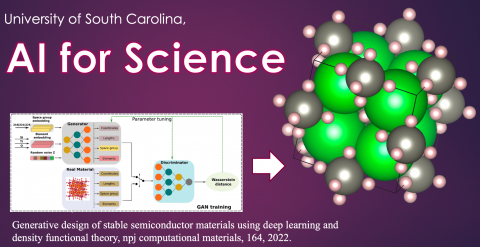 Discovery of novel materials with exceptional properties is fundamental to the technology progress to more efficient solar panels, longer-life batteries, and room-temperature superconductors. Traditionally, the discovery process is a highly ad hoc, empirical, serendipitous process based on inventors’ ingenuity and knowledge. To address this issue, materials scientists now mainly resort to the rational design process, in which they aim to obtain a mechanistic understanding of how materials composition and structures determine their function properties. However, the complexity of these relationships and the difficulty to enumerate all the delicate and intricate design rules makes it challenging to explore the vast chemical design space using such rational design approaches.
Discovery of novel materials with exceptional properties is fundamental to the technology progress to more efficient solar panels, longer-life batteries, and room-temperature superconductors. Traditionally, the discovery process is a highly ad hoc, empirical, serendipitous process based on inventors’ ingenuity and knowledge. To address this issue, materials scientists now mainly resort to the rational design process, in which they aim to obtain a mechanistic understanding of how materials composition and structures determine their function properties. However, the complexity of these relationships and the difficulty to enumerate all the delicate and intricate design rules makes it challenging to explore the vast chemical design space using such rational design approaches.
Now a team of researchers from the Machine Learning and Evolution Laboratory at the University of South Carolina applied a paradigm-shifting deep learning based generative design approach for computational discovery of novel semiconductors. By combining a generative adversarial networks (GAN) model, a metal classifier, and high-throughput first-principles calculations, they have discovered 12 novel stable AA’′MH6 semiconductors in the F-43m space group. They showed that AA′MnH6 and NaYRuH6 semiconductors have considerably different properties compared to the rest of the AA′MH6 semiconductors, which are all wide-bandgap materials and may be ideal for certain applications.
The findings are reported today in the journal Nature npj Computational Materials, in a paper by UofSC postdoc Edirisuriya M. Dilanga Siriwardane, graduate student Yong Zhao, and UofSC Professor of Computer Science Dr. Jianjun Hu (the corresponding author); Indika Perera at the University of Moratuwa.
In their generative design approach, they first train a deep neural network based crystal structure generator model using all known crystal materials deposited in the databases, and then they run these generators to create a large number of hypothetical materials, which are then fed to the metal classifier to filter out potential semiconductors. Then the top candidate structures are fed to the first principle simulation software Vasp for structure relaxation and stability check, and property calculation, which are very slow processes that used the High Performance Clusters (HPC) at the UofSc Research Computing facility.
This work is another success case for the emerging AI-for-Science paradigm conducted by the interdisciplinary team with the computational materials expertise from Dr. Siriwardane and deep learning and computing expertise from Dr. Zhao, Prof. Hu, and Prof. Perera. “Compared to rational design approaches, the deep learning based generative design approach has the special advantage in terms of its capability to efficiently navigate the almost infinite chemical design space of materials, assisted by the implicit, latent, dark knowledge learned by the neural network”, says Prof. Hu. Their new material design approach does not require explicit specification of design knowledge and rules (so, design without understanding), which is in sharp contrast to the traditional rational design methods.
“The deep learning generative models are very good at learning implicit chemical and materials composition knowledge”, says Dilanga, the paper’s lead author. “But the current algorithm can be further improved in terms of their success rates of generating stable structures”. Since the DFT quantum simulation is very slow, it is desirable to have a high hit-rate when they are used for validating the generated hypothetical materials. He adds, “our capability to discover more interesting materials is currently also limited by the computing power at UofSC”.
“Generating thermodynamically and structurally stable crystals structures is a non-trivial problem”, says Zhao, who led the development of the deep generative algorithm. He has recently introduced physical rules and geometric constraints to further improve the quality of the generated crystal structures.
For the discovered materials to become practical on the market or be adopted commercially, Hu says, “our hypothetical materials can guide experimental materials scientists to synthesize and characterize their properties”.
The research was supported by the National Science Foundation and used the HPC computing facility of UofSC.